2012 Peugeot 207 CC gearbox
[x] Cancel search: gearboxPage 114 of 224
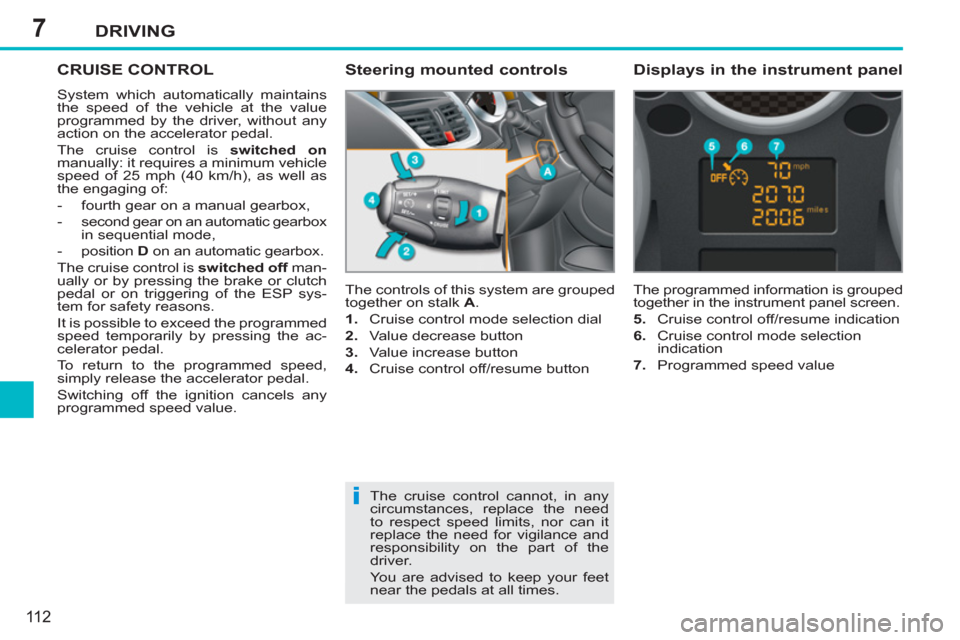
7
i
DRIVING
11 2
CRUISE CONTROL
System which automatically maintains
the speed of the vehicle at the value
programmed by the driver, without any
action on the accelerator pedal.
The cruise control is switched on
manually: it requires a minimum vehicle
speed of 25 mph (40 km/h), as well as
the engaging of:
- fourth gear on a manual gearbox,
- second gear on an automatic gearbox
in sequential mode,
- position D
on an automatic gearbox.
The cruise control is switched off
man-
ually or by pressing the brake or clutch
pedal or on triggering of the ESP sys-
tem for safety reasons.
It is possible to exceed the programmed
speed temporarily by pressing the ac-
celerator pedal.
To return to the programmed speed,
simply release the accelerator pedal.
Switching off the ignition cancels any
programmed speed value. The controls of this system are grouped
together on stalk A
.
1.
Cruise control mode selection dial
2.
Value decrease button
3.
Value increase button
4.
Cruise control off/resume button
The programmed information is grouped
together in the instrument panel screen.
5.
Cruise control off/resume indication
6.
Cruise control mode selection
indication
7.
Programmed speed value
Steering mounted controls
Displays in the instrument panel
The cruise control cannot, in any
circumstances, replace the need
to respect speed limits, nor can it
replace the need for vigilance and
responsibility on the part of the
driver.
You are advised to keep your feet
near the pedals at all times.
Page 124 of 224
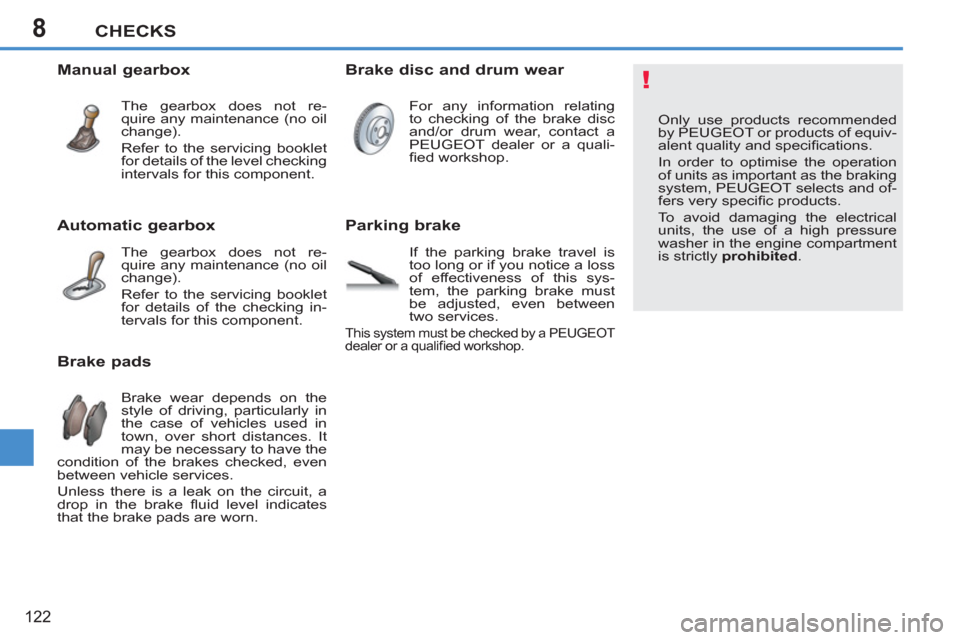
8
!
CHECKS
122
Only use products recommended
by PEUGEOT or products of equiv-
alent quality and specifi cations.
In order to optimise the operation
of units as important as the braking
system, PEUGEOT selects and of-
fers very specifi c products.
To avoid damaging the electrical
units, the use of a high pressure
washer in the engine compartment
is strictly prohibited
.
Automatic gearbox
The gearbox does not re-
quire any maintenance (no oil
change).
Refer to the servicing booklet
for details of the checking in-
tervals for this component.
Brake disc and drum wear
For any information relating
to checking of the brake disc
and/or drum wear, contact a
PEUGEOT dealer or a quali-
fi ed workshop.
Manual gearbox
The gearbox does not re-
quire any maintenance (no oil
change).
Refer to the servicing booklet
for details of the level checking
intervals for this component.
Brake pads
Brake wear depends on the
style of driving, particularly in
the case of vehicles used in
town, over short distances. It
may be necessary to have the
condition of the brakes checked, even
between vehicle services.
Unless there is a leak on the circuit, a
drop in the brake fl uid level indicates
that the brake pads are worn.
Parking brake
If the parking brake travel is
too long or if you notice a loss
of effectiveness of this sys-
tem, the parking brake must
be adjusted, even between
two services.
This system must be checked by a PEUGEOT
dealer or a qualifi ed workshop.
Page 140 of 224

9PRACTICAL INFORMATION
138
Fuse N°
Rating
Functions
F8
20 A
Audio/telephone, multifunction screen, steering
wheel controls, tyre under-infl ation detection, trailer
fusebox, alarm (accessory).
F9
30 A
Front 12 V socket, front courtesy lamp, map reading
lamps, sun visor lighting, glove box lighting.
F10
15 A
Alarm siren, alarm control unit, directional
headlamps.
F11
15 A
Diagnostic socket, low current ignition switch,
automatic gearbox control unit.
F12
15 A
Brightness sensor, trailer fusebox, retractable roof.
F13
5 A
Engine fusebox, ABS relay, dual-function brake
switch.
F14
15 A
Instrument panel, seat belt warning lamp panel, headlamp
adjustment, air conditioning, audio equipment, hands-free
kit, rear parking assistance control unit.
F15
30 A
Locking and deadlocking.
F17
40 A
Rear screen and exterior mirrors demist/defrost.
SH
-
PARC shunt.
Page 141 of 224

9PRACTICAL INFORMATION
139
Fuse N°
Rating
Functions
F1
20 A
Engine control unit and fan assembly control
relay supply, timing and canister electrovalves
(1.6 litre16V THP), air fl ow sensor (Diesel),
injection pump (Diesel), water in diesel sensor
(Diesel), EGR electrovalves, air heating (Diesel).
F2
15 A
Horn.
F3
10 A
Front wash-wipe.
F4
20 A
Headlamp wash.
F5
15 A
Fuel pump (petrol), Turbo electrovalves
(1.6 litre 16V THP).
F6
10 A
Vehicle speed sensor, automatic gearbox.
F7
10 A
Electric power steering, directional headlamps,
directional headlamps control relay, switching and
protection unit (Diesel).
F8
20 A
Starter control.
F9
10 A
ABS/ESP control unit, brake pedal switch.
F10
30 A
Engine control unit actuators (petrol: ignition coils,
electrovalves, oxygen sensors, injectors, heaters,
electronic thermostat) (Diesel: electrovalves,
heaters).
F11
40 A
Air conditioning blower.
F12
30 A
Windscreen wipers Low/High speed.
F13
40 A
Built-in systems interface supply (ignition positive).
Engine compartment fuses
The fuse box is placed in the engine
compartment, near the battery (left-
hand side).
Access to the fuses
�)
Unclip the cover.
�)
Replace the fuse (refer to the cor-
responding paragraph).
�)
When you have fi nished, close the
cover carefully to ensure the sealing
of the fuse box.
Fuse table
Page 146 of 224
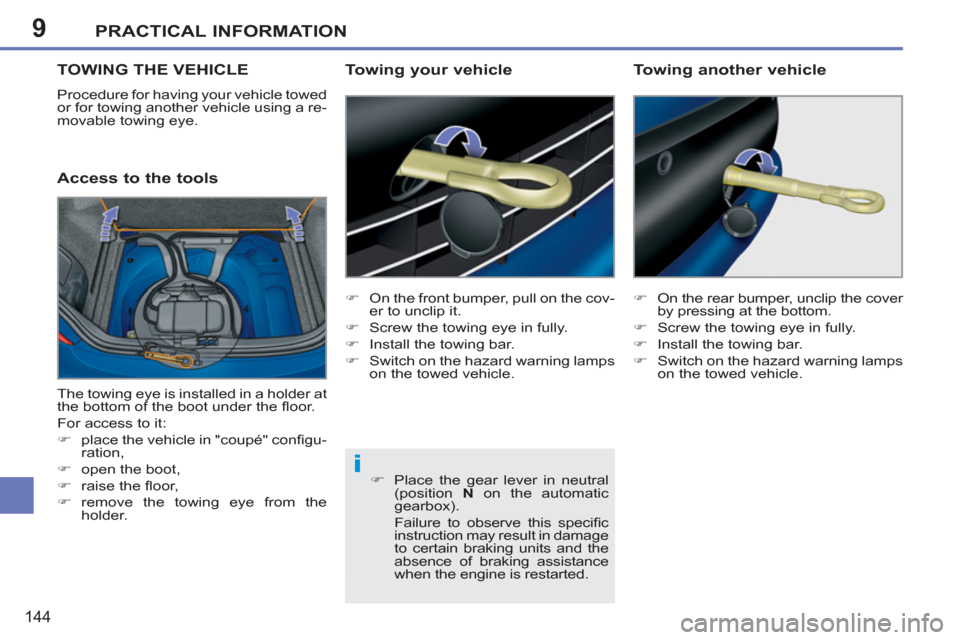
9
i
PRACTICAL INFORMATION
144
TOWING THE VEHICLE
Procedure for having your vehicle towed
or for towing another vehicle using a re-
movable towing eye.
Access to the tools Towin
g your vehicle
�)
On the front bumper, pull on the cov-
er to unclip it.
�)
Screw the towing eye in fully.
�)
Install the towing bar.
�)
Switch on the hazard warning lamps
on the towed vehicle.
�)
On the rear bumper, unclip the cover
by pressing at the bottom.
�)
Screw the towing eye in fully.
�)
Install the towing bar.
�)
Switch on the hazard warning lamps
on the towed vehicle.
Towing another vehicle
The towing eye is installed in a holder at
the bottom of the boot under the fl oor.
For access to it:
�)
place the vehicle in "coupé" confi gu-
ration,
�)
open the boot,
�)
raise the fl oor,
�)
remove the towing eye from the
holder.
�)
Place the gear lever in neutral
(position N
on the automatic
gearbox).
Failure to observe this specifi c
instruction may result in damage
to certain braking units and the
absence of braking assistance
when the engine is restarted.
Page 147 of 224

9
!
i
PRACTICAL INFORMATION
145
General recommendations
Observe the legislation in force in
your country.
Ensure that the weight of the tow-
ing vehicle is higher than that of the
towed vehicle.
The driver must stay at the wheel
of the towed vehicle.
Driving on motorways and fast
roads is prohibited when towing.
When towing a vehicle with all four
wheels on the ground, always use
an approved towing bar; rope and
straps are prohibited.
When towing a vehicle with the
engine off, there is no longer any
power assistance for braking or
steering.
In the following cases, you must al-
ways call on a professional recovery
service:
- vehicle broken down on a mo-
torway or fast road,
- when it is not possible to put the
gearbox into neutral, unlock the
steering, or release the parking
brake,
- towing with only two wheels on
the ground,
- where there is no approved
towing bar available...
TOWING A TRAILER
Your vehicle is primarily designed for
transporting people and luggage, but it
may also be used for towing a trailer. Driving with a trailer places greater de-
mands on the towing vehicle and the
driver must take particular care.
Distribution of loads
�)
Distribute the load in the trailer so
that the heaviest items are as close
as possible to the axle and the nose
weight approaches the maximum
permitted without exceeding it.
Air density decreases with altitude, thus
reducing engine performance. Above
1 000 metres, the maximum towed load
must be reduced by 10 % for every
1 000 metres of altitude.
Refer to the "Technical Data" section for
details of the weights and towed loads
which apply to your vehicle.
Side wind
�)
Take into account the increased
sensitivity to side wind.
Towbar suitable for the attachment of a
trailer with additional lighting and sig-
nalling.
We recommend the use of genuine
PEUGEOT towbars and their har-
nesses that have been tested and
approved from the design stage of
your vehicle, and that the fi tting of the
towbar is entrusted to a PEUGEOT
dealer or a qualifi ed workshop.
If the towbar is not fi tted by a PEUGEOT
dealer, it is imperative that it is fi tted in
accordance with the vehicle manufac-
turer's instructions.
Driving advice
Cooling
Towing a trailer on a slope increases
the temperature of the coolant.
As the fan is electrically controlled, its
cooling capacity is not dependent on
the engine speed.
�)
To lower the engine speed, reduce
your speed.
Page 150 of 224
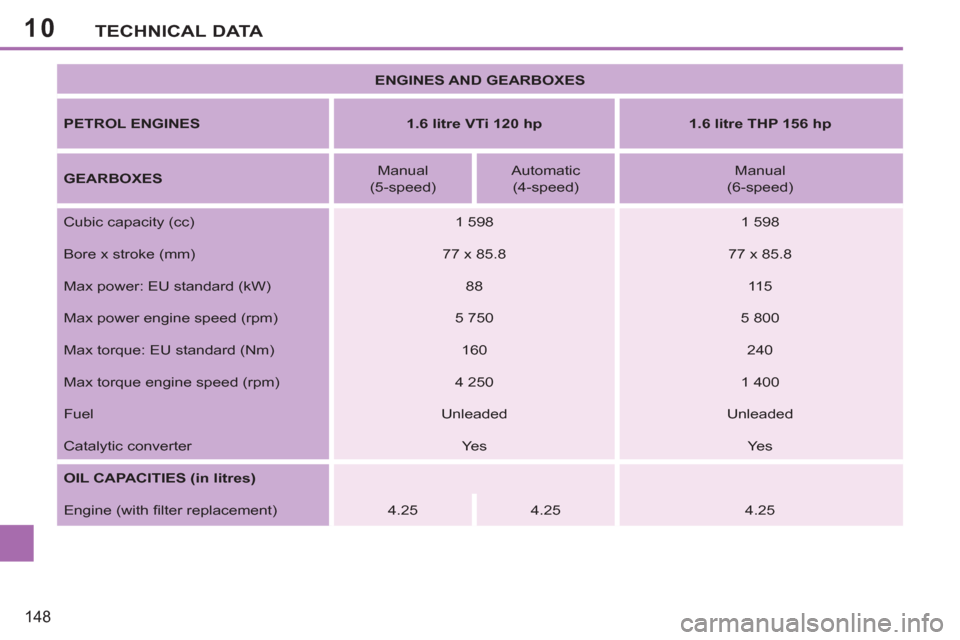
10
148
TECHNICAL DATA
ENGINES AND GEARBOXES
PETROL ENGINES
1.6 litre VTi 120 hp
1.6 litre THP 156 hp
GEARBOXES
Manual
(5-speed)
Automatic
(4-speed)
Manual
(6-speed)
Cubic capacity (cc)
1 598
1 598
Bore x stroke (mm)
77 x 85.8
77 x 85.8
Max power: EU standard (kW)
88
115
Max power engine speed (rpm)
5 750
5 800
Max torque: EU standard (Nm)
160
240
Max torque engine speed (rpm)
4 250
1 400
Fuel
Unleaded
Unleaded
Catalytic converter
Yes
Yes
OIL CAPACITIES (in litres)
Engine (with fi lter replacement)
4.25
4.25
4.25
Page 151 of 224
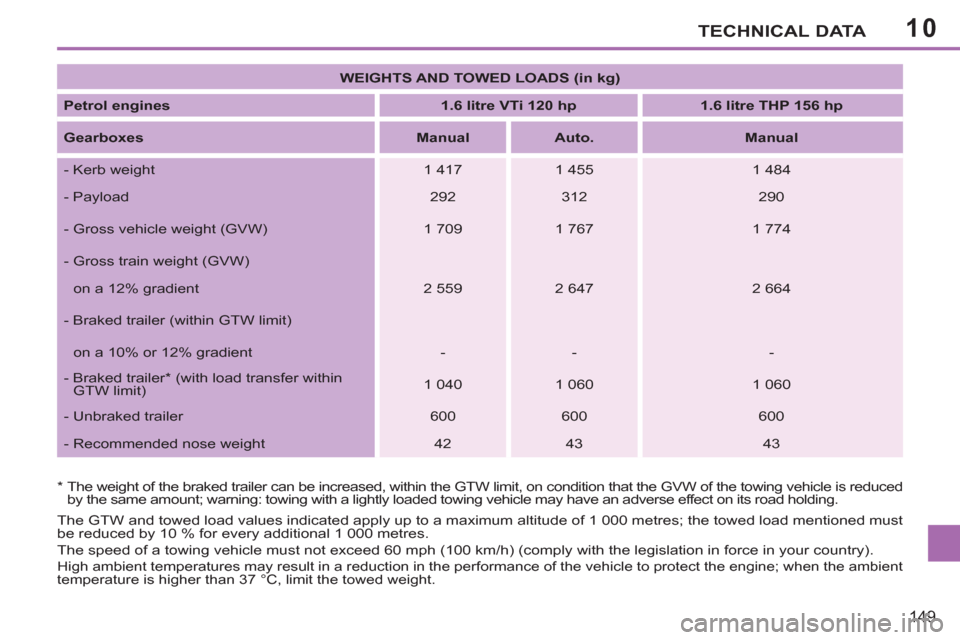
10TECHNICAL DATA
149
The GTW and towed load values indicated apply up to a maximum altitude of 1 000 metres; the towed load mentioned must
be reduced by 10 % for every additional 1 000 metres.
The speed of a towing vehicle must not exceed 60 mph (100 km/h) (comply with the legislation in force in your country).
High ambient temperatures may result in a reduction in the performance of the vehicle to protect the engine; when the ambient
temperature is higher than 37 °C, limit the towed weight.
*
The weight of the braked trailer can be increased, within the GTW limit, on condition that the GVW of the towing vehicle is reduced
by the same amount; warning: towing with a lightly loaded towing vehicle may have an adverse effect on its road holding.
WEIGHTS AND TOWED LOADS (in kg)
Petrol engines
1.6 litre VTi 120 hp
1.6 litre THP 156 hp
Gearboxes
Manual
Auto.
Manual
- Kerb weight
1 417
1 455
1 484
- Payload
292
312
290
- Gross vehicle weight (GVW)
1 709
1 767
1 774
- Gross train weight (GVW)
on a 12% gradient
2 559
2 647
2 664
- Braked trailer (within GTW limit)
on a 10% or 12% gradient
-
-
-
- Braked trailer * (with load transfer within
GTW limit)
1 040
1 060
1 060
- Unbraked trailer
600
600
600
- Recommended nose weight
42
43
43